- Blog
- Why no single popup can solve all your problems?
Why no single popup can solve all your problems?
-
Csaba Zajdo
- Conversion
- 6 min read
Table of Contents
Have you ever launched a beautifully designed popup—only to watch your visitors ignore it like it’s not even there? You double-checked your copy, made sure your CTA was strong, and maybe even sweetened the deal. But still… crickets.
If this sounds familiar, you’re not alone. We’ve all been there, scratching our heads and wondering: Why isn’t this working?
The hard truth is, your popup might be great—but it’s probably not relevant. And relevance is everything.
In this article, we’ll dive into why a one-size-fits-all approach to popups just doesn’t cut it anymore. We’ll explore how different users come to your site with different goals, and how personalization can dramatically boost your conversion rates.
Let’s dive in.
Why no single popup can solve all your problems?
Let’s say you created a popup with a concrete goal in mind: you wanted to build your email marketing list. So you put a lot of energy into designing a beautiful popup and crafting your best possible copy. But unfortunately, it turns out that the vast majority of users are simply NOT interested in joining your list.
We’ve been in this frustrating situation more times than we can count, left wondering why people are ignoring the awesome offer we’ve dreamed up.
Well, clearly something’s not working.
To figure out what that might be, let’s pretend we have an online jewelry store and we’ve decided to run a giveaway on a diamond necklace worth $2,000. To enter, all a visitor has to do is sign up for our email marketing list.
Pretty irresistible, right?
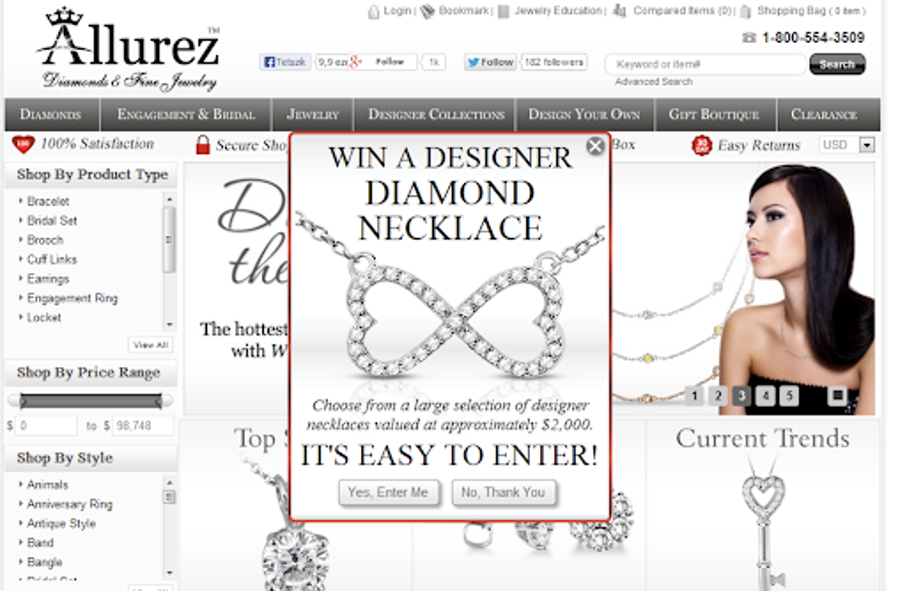
Ok, now let’s say we have a visitor named Ben. Ben is 38 years old, and he’s engaged to be married. He’s shopping for a beautiful wedding ring for his fiancée.

Will Ben be interested in our offer?
Most likely not—after all, he’s looking for a wedding ring. But that means that he would definitely be interested in a discount offer on an exclusive line of wedding rings.
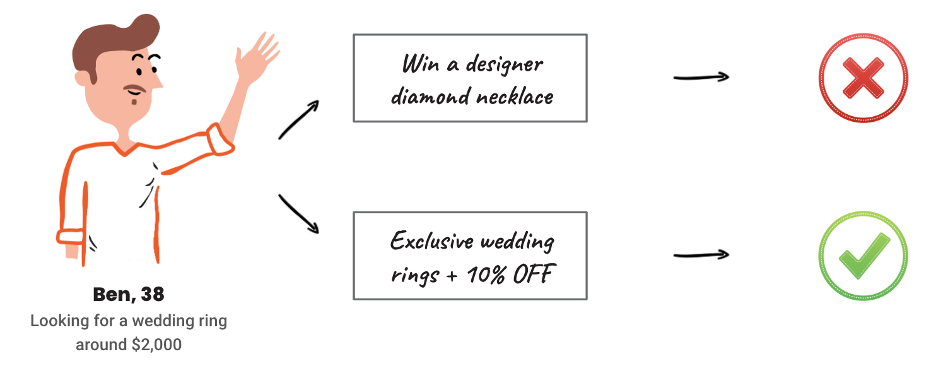
Unfortunately, the solution isn’t as easy as changing our offer from the diamond necklace giveaway to a 10% discount on wedding rings. We have other visitors to think about, too!
Among them is Kate, 26, who’s looking for a birthday gift for her friend.
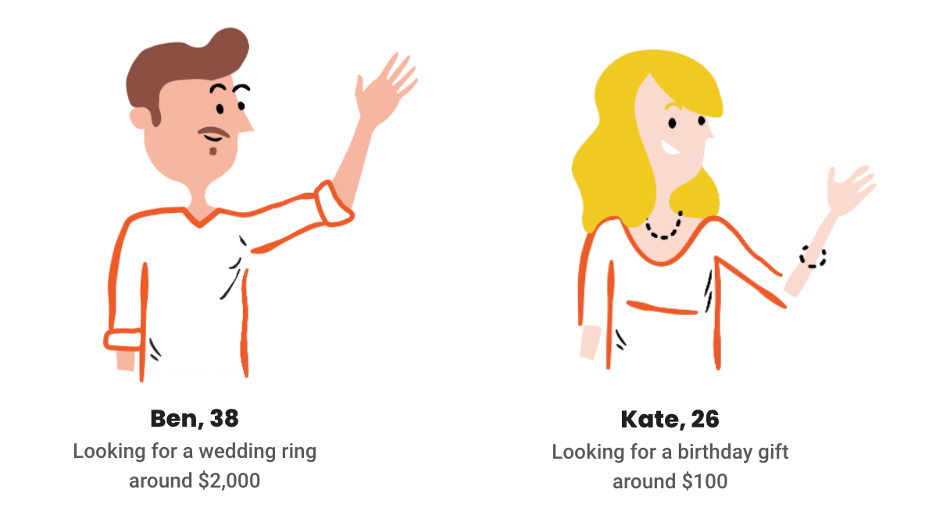
It goes without saying that our wedding ring offer won’t resonate with Kate.
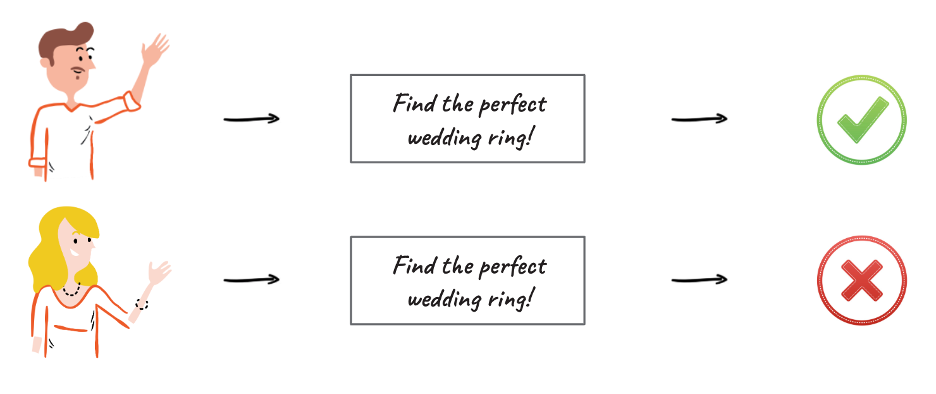
But she would love to see gift ideas around $100!
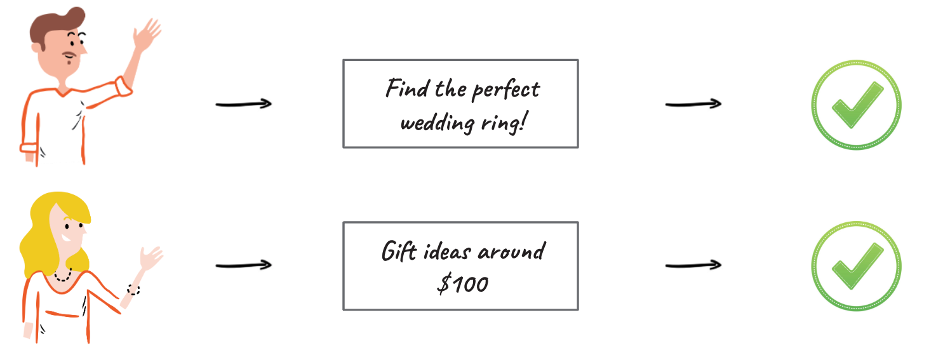
As you can see, there’s no single message that would work for both users.
And we haven’t even talked about the thousands of other users, all of whom have their own unique goals and preferences!
So what’s the solution?
The solution: personalization
The optimal solution would be personalizing your messages for each individual visitor. In reality, that’s not feasible, because:
- You have limited knowledge about individual preferences
- You can’t create a separate popup for each user
But there’s good news. Even though perfect personalization isn’t possible, you can still create relevant messages by tailoring your content toward well-defined segments of customers.
The even better news is that you already have lots of information about your visitors… it’s stored in the data that your ecommerce site and your tools (including OptiMonk) collect about your users. And you can use all that data for personalization.
Here are some examples of types of data and customer relationships that any ecommerce retailer can use:
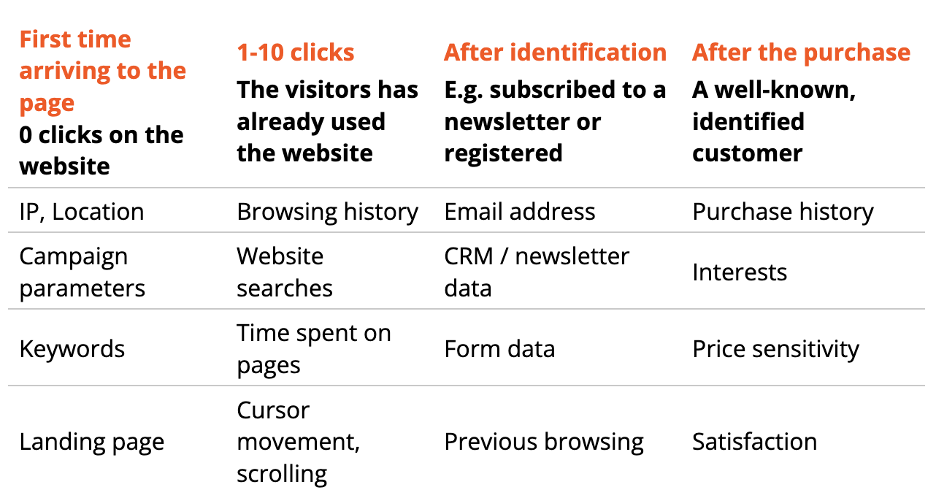
Based on this data, you can create segments (often called homogenous groups) and craft personalized messages for each group.
Here are a few practical ideas for personalizing your messages based on these data points:
- IP, Location: If a shopper’s IP address is from Germany, you can show them a popup informing them that you ship to Germany.
- Campaign parameters: If a visitor arrived on your site by clicking a Facebook campaign targeted at 25 to 35-year-olds, then you can assume they are in that age range. You can make similar inferences based on all your campaign parameters.
- Keywords: If a visitor googled a “how-to” question and landed on your store, you can assume they’re already problem aware.
- Browsing history: If a visitor reads your blog posts about racing bikes, then you should probably show them an ad for a racing bike.
- Cursor movement, scrolling: If a visitor has been on a page for a full minute and scrolled through 80 percent of the content, you can assume they were interested in the content and actually read it.
- Form data: If a visitor fills out a “How to select a bike” quiz and selects “from a city” and “woman,” you can send them content related to these characteristics.
- Interests: If a visitor has bought iPhone accessories several times before, they presumably have an iPhone and therefore you shouldn’t recommend Android accessories to them.
- Price sensibility: If a visitor has only ever bought products during your sales and special promotions, they are probably very price sensitive, which means you should draw their attention to new promotions. The same goes for visitors arriving from shopping engines like Google Shopping and Shopzilla.
These are just a few examples.
Depending on your industry, your store, and even the marketing platforms you use, different data points will be more or less useful to you than they would be for another store. The limit is usually your creativity and the amount of time you’re willing to invest in personalization.
How much time should one invest in personalization?
There’s not really a single, fixed answer. The more traffic you have, the bigger impact personalization (even on a smaller scale) will have.
Whatever your current situation, it’s important to get your priorities right. Many companies put a lot of effort into personalizing emails so a few thousand email subscribers will get better, more personalized emails.
However, those same companies often shy away from investing the same resources into creating more personalized on-site messages. Crazy, since doing so would improve the experience of the same number of people—every day!
Final thoughts
The wave of personalization in ecommerce isn’t even close to reaching its peak. As customers become increasingly accustomed to seeing personalization across the web, it’s more important than ever that you keep up.
So… will you start personalizing your website with multiple popups and skyrocket your conversion rates? Or will you continue pushing the same message to everyone? The choice is yours.
Related articles:
Migration has never been easier
We made switching a no-brainer with our free, white-glove onboarding service so you can get started in the blink of an eye.

What should you do next?
Thanks for reading till the end. Here are 4 ways we can help you grow your business:
Boost conversions with proven use cases
Explore our Use Case Library, filled with actionable personalization examples and step-by-step guides to unlock your website's full potential. Check out Use Case Library
Create a free OptiMonk account
Create a free OptiMonk account and easily get started with popups and conversion rate optimization. Get OptiMonk free
Get advice from a CRO expert
Schedule a personalized discovery call with one of our experts to explore how OptiMonk can help you grow your business. Book a demo
Join our weekly newsletter
Real CRO insights & marketing tips. No fluff. Straight to your inbox. Subscribe now
Csaba Zajdo
- Posted in
- Conversion
Partner with us
- © OptiMonk. All rights reserved!
- Terms of Use
- Privacy Policy
- Cookie Policy
Product updates: January Release 2025








